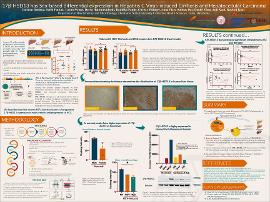| dc.contributor.author | Deniega, Carldon | |
| dc.contributor.author | Pathak, Sachi | |
| dc.contributor.author | Swope, Logan | |
| dc.contributor.author | Hajimirsadeghi, Dorsa | |
| dc.contributor.author | Pande, Radhika | |
| dc.contributor.author | Eslinger, Christy | |
| dc.contributor.author | Platt, Anna | |
| dc.contributor.author | Das, Subhas | |
| dc.contributor.author | Zhao, Daniel | |
| dc.contributor.author | Kaul, Anil | |
| dc.contributor.author | Kaul, Rashmi | |
| dc.date.accessioned | 2023-11-02T20:44:09Z | |
| dc.date.available | 2023-11-02T20:44:09Z | |
| dc.date.issued | 2023-02-17 | |
| dc.identifier | ouhd_Deniega_17betahydroxysteroiddehydrogenase13_2023 | |
| dc.identifier.citation | Deniega, C., Pathak, S., Swope, L., Hajimirsadeghi, D., Pande, R., Eslinger, C., Platt, A., Das, S., Zhao, D., Kaul, A., and Kaul, R. (2023, February 17). 17β-HSD13 has sex-based differential expression in Hepatitis C virus-induced cirrhosis and hepatocellular carcinoma. Poster presented at Research Week, Oklahoma State University Center for Health Sciences, Tulsa, Ok. | |
| dc.identifier.uri | https://hdl.handle.net/11244/339879 | |
| dc.description.abstract | Background: Sex-based differences are observed in chronic hepatitis C virus (HCV) infections leading to cirrhosis and hepatocellular carcinoma (HCC). We previously showed that liver estrogen receptor (ER-) mediated sex-based differences exist in cirrhosis and HCC. Liver ER-binding may lead to protective effects in pre-menopausal women. This study aimed to determine sex-based differential role of 17βHSD13 in development of cirrhosis and HCC. We hypothesized that chronic HCV infection leads to dysregulated 17β-HSD13 in male cirrhosis and progression to HCC. | |
| dc.description.abstract | Methods: 65 (normal, cirrhosis, HCC) liver tissues were obtained from NIH Liver Tissue Bank. DIA proteomics mapped 4445 proteins, including 17β-HSD13. Clinical correlation with bilirubin, AST, ALP, and creatinine was determined (spearman’s). Immunohistochemistry validated 17β-HSD13 protein expression in tissues. | |
| dc.description.abstract | Results: 17β-HSD13 had significantly lower expression in male cirrhosis group than females (P<0.05). In contrast, 17β-HSD13 expression in normal males was significantly greater than normal females (P<0.05). In HCC group, the expression in males was down-regulated compared to HCC females (P<0.05). Bilirubin values showed negative correlation with 17β-HSD13 expression (P<0.05) between cirrhosis and HCC (males alone and combined sex data). | |
| dc.description.abstract | Conclusions: Low 17β-HSD13 levels may predict worse disease in males with cirrhosis or HCC serving as disease biomarker. This novel report shows sex-based differences in 17β-HSD13 during HCV-induced cirrhosis development. | |
| dc.format | application/pdf | |
| dc.language | en_US | |
| dc.publisher | Oklahoma State University Center for Health Sciences | |
| dc.rights | The author(s) retain the copyright or have the right to deposit the item giving the Oklahoma State University Library a limited, non-exclusive right to share this material in its institutional repository. Contact Digital Resources and Discovery Services at lib-dls@okstate.edu or 405-744-9161 for the permission policy on the use, reproduction or distribution of this material. | |
| dc.title | 17β-HSD13 has sex-based differential expression in Hepatitis C virus-induced cirrhosis and hepatocellular carcinoma | |
| osu.filename | ouhd_Deniega_17betahydroxysteroiddehydrogenase13_2023.pdf | |
| dc.type.genre | Presentation | |
| dc.type.material | Text | |
| dc.subject.keywords | 17β-HSD13 | |
| dc.subject.keywords | Hepatitis C virus | |
| dc.subject.keywords | liver cirrhosis | |
